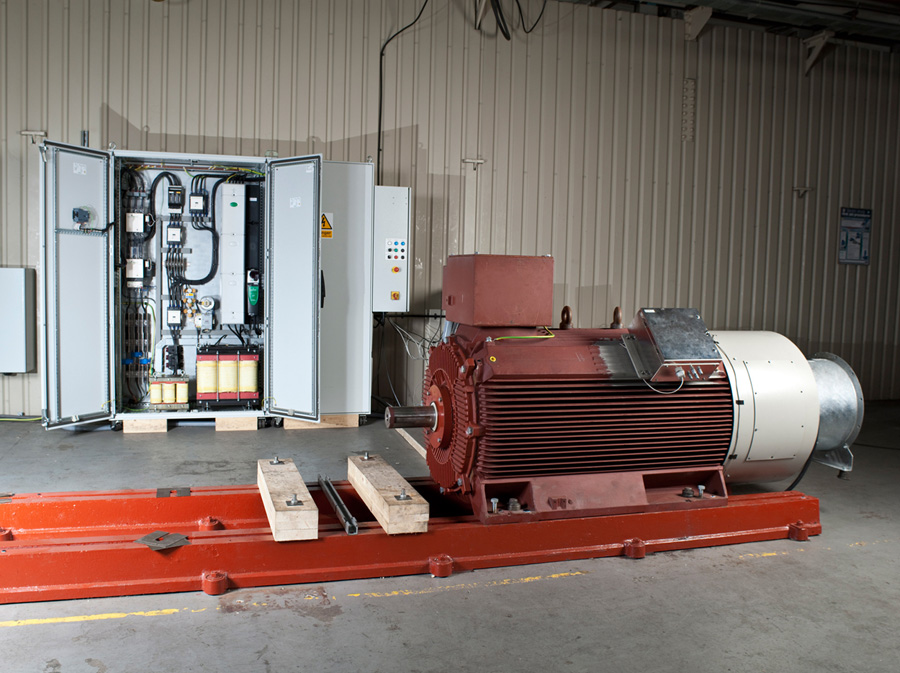Control Techniques Drives Chosen For Test Rig
Wind Technologies has recently completed testing on a radically different type of generator – one that has the potential to make radical cuts in the cost of operation & maintenance of wind turbines

Control Techniques Drives ChosenOperating and maintenance costs are a growing issue, particularly for off-shore wind farms. The design is for a brushless doubly-fed induction generator, which not only increases the reliability of wind turbines, but also reduces the size requirement for the associated converter to one-third of the generator rating.
The technology was developed at Cambridge & Durham Universities from 1999 and a 20 kW machine was first tested in a Gazelle wind turbine in 2009 – the world’s first brushless doubly-fed generator (known as a Brushless DFIG) fitted into a wind turbine. This completely proved the theoretical models, but was just the first step!
With sights set on a multi-MW machine, the team opted for intensive testing of a 250 kW brushless generator, built to their specifications by ATB Laurence Scott Ltd in Norwich. Wind Technologies designed a test rig with double power feed – mains power and connection via the controlling inverter drive – with a Control Techniques Unidrive providing grid connection.
“We chose Control Techniques partly because it is a British product, but mainly because of the excellent support,” explains Dr Paul Malliband, Vice President Engineering at Wind Technologies. “It’s always possible to get hold of an engineer to help with a technical query, even during weekends. We have developed a very good relationship over the period of this project,” he adds.
Wind Technologies’ Brushless DFIG has two stator windings of different pole numbers in a single frame, chosen so that there is no direct coupling between them, in combination with a special form of rotor which can couple both fields. It has a number of benefits.
Its brushless operation drastically cuts its build cost (CAPEX) as well as the level and frequency of maintenance (OPEX) with the elimination of slip-rings and brush gear. The generator no longer requires brush carbon extraction equipment, further reducing manufacturing costs and no carbon brush dust spreads into the turbine nacelle due to brush wear. This also removes a major maintenance routine from the generator. These advantages become even more significant for off-shore wind turbines.
Because the Brushless DFIG has doubly-fed operation, it only requires a fractionally rated converter, again saving overall costs. It also shows greater compatibility with grid codes than the conventional DFIG, thereby providing further CAPEX benefits.
The Wind Technologies Brushless DFIG is, by nature, a 'medium-speed' generator, so its best operation in a wind turbine is achieved when coupled to a one or two stage gearbox. This offers an important reliability improvement by eliminating the high-speed stage(s) of the gearbox and hence simplifying the mechanical system. Independent studies have shown that Wind Technologies’ innovative drive-train solution is 10% more reliable than the conventional drive-train comprising a DFIG and a three stage gearbox.
Testing of the Brushless DFIG has recently been completed at the ATB Laurence Scott factory in Norwich. The grid-side connection is by a 90 kW Control Techniques Unidrive SP AC drive, operating in regeneration mode. Wind Technologies’ configuration provides ride-through in the event of a mains fault – up to 2 seconds – a control algorithm immediately reduces the power from the generator to zero, eliminating the need for a ‘crowbar’, used for dumping excess power. The test rig has sensors to measure rotor current, flux and rotor temperature – unusually with Bluetooth transmission of the data.
The Unidrive SP ‘Solutions Platform’ AC variable speed drive range spans 0.37 kW right up to 1.9 MW. It is configurable into five operating modes – open loop, RFC (rotor flux control), closed loop vector, servo & regenerating modes. With a range of plug-in option modules, its onboard PLC can be supplemented with programmable, specialist feedback and communication modules.
A multi-MW drive-train is now being designed by Wind Technologies’ engineering team and this will be incorporated into a wind turbine for field testing in 2013. The drive-train will include a Brushless DFIG and its associated frequency converter and control system, coupled to a two stage gearbox.
CONTACT
Andy Cann
Control Techniques, Emerson
andy.cann@emerson.com
www.controltechniques.com
+44 (0) 1686 612996
Friday 13 April 2012 / file under Technology | Machinery | Environmental | Engineering



